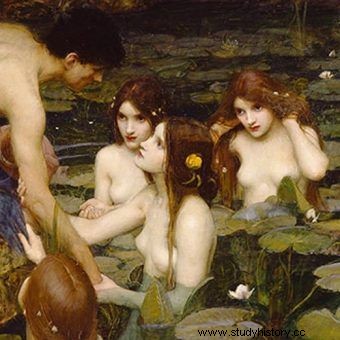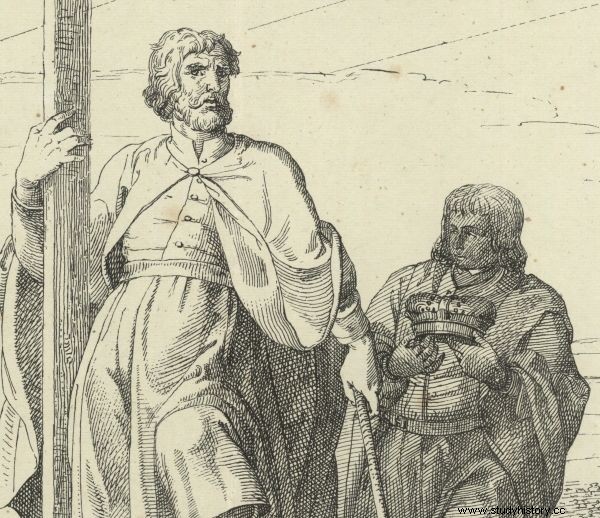Gall Anonymous explained that the first Christian ruler of Poland "was immersed in such errors of paganism that, according to the custom of his people, he took seven wives." The number of partners was probably sucked out of the finger by the chronicler. But what about the harem itself at the dawn of our history?
Gall's mention of the seven concubines is all too obvious a reference to the seven deadly sins and to religious symbolism. This does not mean, however, that the very information about the polygamy of the ruler of Wielkopolska is also false.
Completely ordinary… debauchery
Everything indicates that Mieszko did in fact maintain a large harem. It was not uncommon among Slavic leaders. In the company of seven wives, Vladimir the Great, the ruler of Rus, was to spend intoxicating nights before his baptism. In turn, the Pomeranian prince Warcisław was credited with having as many as twenty-four partners.

It wasn't all about sex at all. Mieszko surrounded himself with a wreath of beautiful young women to emphasize his own position and prove his wealth.
Harem met the personal needs of the ruler, but also emphasized his wealth and power. After all, only a truly influential man could afford to provide beautiful clothes, jewelry, food and luxurious accommodation to not one, but several or a dozen women.
Wives or concubines?
If anything is in doubt, it is the nature of similar relationships. The chronicler Wincenty Kadłubek, who wrote at the end of the 12th century, corrected Gall's story, claiming that Mieszko did not have seven wives, but "seven prostitutes", with whom he took turns to spend the nights and whom he only "called his wives".
One of the later chroniclers further developed Kadłubka's interpretation, suggesting that the prince did not alternately bask in the charms of his courtesans, but amused himself with everyone at once by showing his youthful vigor. This last detail is difficult to verify. However, the very fact that Mieszko had concubines rather than full-fledged wives can be taken for granted today.
A bachelor with trials
It is possible that one of his partners held the privileged position of "first wife" but was dismissed or died. So, formally, Mieszko was considered a bachelor and nothing prevented him from marrying Dobrawa in 965. 
Even more so, there was nothing to argue that, for such a trivial reason as a wedding with a woman adhering to different customs, the ruler should get rid of the entire retinue of young and beautiful concubines.
Patterns from abroad
We know too many examples when a wreath of a lover was surrounded by already baptized chiefs . In the times of Mieszko, this was the case, for example, in the nearby Czech Republic. If you believe Bruno of Kwerfurt, who was created half a century later, the ruler of Libice, Sławnik, preferred to spend time "with a whole group of women" than associate with his wife, Strzeżysława.

Mieszko I on 19th-century lithography. A truly alluring bachelor?
It was probably similar on the Warta River. And thus Dobrawa had a particularly hard nut to crack if she wanted to convince her husband to be baptized and strengthen her own position at court. The harder it is, if we take into account that on the wedding night she firmly refused to go with Mieszko to the ducal bedroom ... You can read about it in our other article.
***
They have no place in the works of scientists, and the authors of the encyclopedia stubbornly repeat that nothing is known about them. Dobrawa, Oda and Emnilda have been almost completely erased from our history. Completely wrong. Kamil Janicki proves that if it were not for these women, Poland would not exist at all. And that a lot can be said about their lives without resorting to presumptions and fairy tales. This is the fascinating story of the ruthless, ambitious and power-hungry partners of the first Piasts.
Sources:
The article is based on the literature and materials collected by the author during the work on the book "Iron Ladies. The Women Who Built Poland ” .
Primary sources:
- Gall Anonim, Polish Chronicle , Fr. I, chap. 4-5.
- Chronicle of Dzierzwa , chap. 18.
- Wincenty Kadłubek, Polish Chronicle , Fr. II, ch. 8.
Literature:
- Banaszkiewicz J., Dąbrówka "christianissima" and Mieszko a pagan (Thietmar, IV, 55-56, Gall I, 5-6) [in:] Nihil superfluum esse , eds. J. Strzelczyk, J. Dobosz, Poznań 2000.
- Jasiński K., Pedigree of the first Piasts , Poznań 2004.
- Krawiec A., Sexuality in Medieval Poland , Poznań 2000.
- Moszyński K., Folk culture of the Slavs , vol. 2, Warsaw 1967.
- Strzelczyk J., Bolesław the Brave , Warsaw 2014.
- Vlasto A.P., The Entry of the Slavs Into Christendom. An Introduction to the Medieval History of the Slavs , Cambridge 1970.
